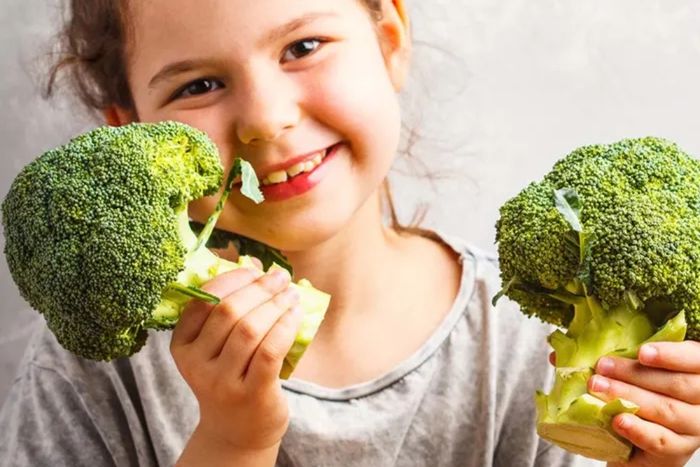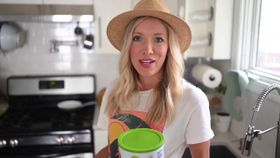Toddler Constipation Relief
Is your toddler truggling with hard, painful stools? This post shares easy home remedies to help your toddler poop more easily.
Updated May 30, 2024.

Noticing a change in your child’s bowel habits can spark concern for parents and caregivers. However, you can rest assured knowing that bowel changes, particularly constipation in children, are very common.
Your child may be constipated if they’re having infrequent bowel movements or dry, hard stools that are difficult to pass. Most cases of constipation in toddlers are temporary and can often be remedied with some simple changes to their diet and routine.
» Ensure the baby's bowel health with this plant-based toddler nutrition
How Do I Know if My Toddler is Pooping Enough?
If you’re a parent, you may find yourself asking how often a toddler should poop? It is important to note that bowel patterns can vastly differ from child to child. Therefore, what’s normal for your child may be completely different than what’s normal for another child. For example, other children may poop 1 to 2 times per day while your child may poop every 2 to 3 days normally.
According to the American Academy of Pediatrics, constipated toddlers generally present with stools that are hard, dry, and difficult to pass. Other signs and symptoms of constipation may include:
- Many days between bowel movements
- Straining when pooping
- Bleeding in a child’s rectum
- Stomachaches, cramping, and nausea
- Having a swollen abdomen or bloating
- Brownish wet spots in their underwear, also known as encopresis
If you notice any of these signs or symptoms, it may mean that your child is not pooping enough and that they may have constipation.
» Learn all the signs and symptoms that your baby doesn't agree with formula
What Causes Toddler Constipation?
The cause of toddler constipation is similar to that of adults. A change in routine or a change in dietary habits can wreak havoc on your child’s delicate gastrointestinal system and lead to constipation.
Your child’s constipation symptoms may come on slowly, or you may notice sudden changes in their bowel habits. Either way, it’s important to know what causes constipation and to try your best to aim for prevention.
The following are some of the causes of toddler constipation:
Changes in Routine
Starting daycare or preschool, traveling, or moving to a different house are all big changes that can trigger constipation in your child. If your child is accustomed to using the same bathroom at certain points throughout the day, or have been toilet training in a certain bathroom and they suddenly find themselves in a new place, constipation may often ensue.
» Learn how to foster positive food relationships amidst changes in routine
Low-Fiber Diet
Many of your typical toddler-friendly foods like crackers and puffs tend to be highly processed and low in fiber leading to a sluggish gastrointestinal system. If your child is experiencing constipation, doctors may recommend simply increasing their fiber, drinking fruit juice and adequate water intake may solve the problem. We’ll advise you on how to do that later.
» Explore our tips for combating a low-fiber diet with high-fiber foods for kids
Holding it in
If you’re in the throes of potty training, then you know all too well how challenging this can be for kids and parents alike. Learning to use the toilet may spark fear, embarrassment, and skepticism in your child.
Additionally, toddlers are notorious for wanting a sense of independence and control. Holding in their stool may be their way of taking charge of a situation that feels out of control for them.
During potty training, children should be encouraged to sit on the toilet and try to poop for 5 to 10 minutes at the same time of day, every day, after the same meal. This will encourage a routine that can ease your child’s mind and help prevent “holding it in”
Illness or Medications
Feeling under the weather can alter your child’s appetite and in turn, disrupt their gastrointestinal system leading to constipation. Furthermore, constipation may be a side effect of certain medications your child may be taking.
» Read our guide on managing a sick toddler's diet when they're on medications
Hydration Status
Fiber and water work hand-in-hand to contribute to your toddler’s constipation relief. Not drinking enough water can slow their system down, triggering stools that are harder to pass.
Activity Level
Plenty of physical activity can help prevent constipation in adults, and the same rings true for kids. Exercise can encourage bowel movements, so try to get your child to walk, ride a bike, or play catch every day.
How Much Fiber Does My Toddler Need?
Eating adequate amounts of fiber can promote healthy bowel functioning and help protect against constipation. Many carb-loving toddlers tend to avoid high fiber foods like fruits and vegetables, leaving parents wondering if their child is getting enough.
» Learn how fiber foods enhance plant-based nutrition for toddlers
The requirement for fiber can vary with age, weight, and energy needs. However, as a general rule of thumb, children 1 to 3 years need approximately 19 grams of fiber per day, while children 4 to 8 years need roughly 25 grams of fiber per day.
Generally speaking, good sources of fiber include fresh fruits and vegetables, beans, legumes, and whole grains.
Examples of high-fiber foods include:
- Beans or lentils, ½ cup: 6-9 grams of fiber
- Raspberries or blackberries, 1 cup: 8 grams of fiber
- Avocado, ½: 7 grams of fiber
- Cooked peas, ½ cup: 7 grams of fiber
- Whole-grain cereal, ¾ cup: 6 grams of fiber
- Whole-grain bread, 1 slice, 2-5 grams of fiber
- Blueberries, 1 cup: 4 grams of fiber
- Pear with skin, ½: 3 grams of fiber
- Broccoli, cooked, ½ cup: 2.5 grams of fiber
- Apple, ½: 2 grams of fiber
- Raisins, 1 oz: 1 gram of fiber
What Foods Will Help a Toddler Poop and Prevent Constipation?
The key to preventing constipation is to ensure your toddler is eating plenty of fiber and drinking plenty of water. Fiber is the part of plant foods that you can’t digest. There are two different types of fiber: soluble and insoluble.
Soluble fiber absorbs water within your child’s GI system and forms a gel-like substance that keeps stools soft.
Insoluble fiber adds bulk and moisture to the stool making it easier to pass. Both types of fiber can be helpful in preventing constipation.
» Explore the benefits of incorporating fiber into your child's whole food diet
The following are practical ways to ensure your child is receiving adequate fiber and hydration:
Aim for 5 Fruits and Vegetables Per Day
Rather than count the number of fiber grams your child is eating, simply offer 5 age-appropriate fruits and vegetables to your child every day.
Some of the best high-fiber fruits include berries, plums, raisins, apricots, pears, and prunes. Some of the best high-fiber veggies include broccoli, sweet potato (with skin), and cooked peas. Note that it’s always best to choose fruits and vegetables in their whole form, versus juice, as the latter lacks fiber.
Swap Out Refined Grains for Whole Grains
Since refined grains like white bread and white rice have very little fiber, try swapping them out for whole grains like whole-wheat bread and brown rice. Other whole grains to try include whole-wheat pasta, oats, quinoa, and fiber-rich cereals.
» Check out our tips for swapping refined grains with whole foods for your baby
Add Beans and Legumes
Chickpeas, lentils, black beans, and kidney beans are all good sources of fiber and can be easily added to different meals and snacks. For example, hummus can be spread on toast, or your child may want to try a delicious bean soup.
Provide Enough Water
According to the American Academy of Pediatrics, to stay well hydrated and to help prevent constipation, children ages 1 to 3 years need approximately 4 cups of water every day. This amount increases for older kids to around 5 cups for 4 to 8-year-olds.
It’s important to note that the water amount recommendations will vary by individual and should be adjusted depending on your child’s activity levels. Additionally, if you live in a climate with higher heat and humidity, your child should drink more than the recommended amounts to ensure they are well-hydrated. A simple trick to teach your child is to examine the color of their urine to verify their hydration status. Urine should be a pale yellow color — dark yellow indicates dehydration, while clear can indicate overhydration.
» Check out our advice on using water and dietary changes to reduce constipation and toxins
Serious cases
In extreme cases children may need to use a laxative or stool softener such as Miralax. This should not be taken without a doctors recommendation or consent. These will help to soften the stools in order to pass through the anus without pain.
What Foods Should a Constipated Toddler Avoid?
If your toddler is experiencing constipation, it can help to limit or even eliminate certain foods that may be contributing to the problem. For example, some people find that dairy can make constipation worse, particularly for kids who have a dairy sensitivity.
» Learn about the best milk alternatives for toddlers with sensitive stomachs
Highly processed foods like fast food, hot dogs, and microwavable dinners are not only low in fiber, but are also high in sodium. Sodium can change the fluid balance in your child’s body, which can contribute to harder-to-pass stools.
You may consider limiting your child’s intake of foods that are full of refined grains while your child is constipated. Foods like white rice, white bread, and white pasta are low in fiber and may further slow your child’s digestion.
To help prevent or relieve constipation, your child should consider limiting or eliminating the following foods:
- Fast food
- Dairy
- Highly processed snack foods like chips
- Highly processed meats like hot dogs, bacon, and sausage
- Microwavable meals
10 Recipes for Constipated Toddlers
🍐🧡Pear Smoothie
Ingredients:
- 1 ½ cup pear nectar juice
- 1 cup packed baby spinach
- 1 cup frozen blueberries
- 1 tbsp ground flax or chia seeds
Instructions:
- Place all of your ingredients into a blender and blend for 2 to 3 minutes to ensure that all chunks of fruits and vegetables are completely smooth.
- You can add extra pear nectar juice, water, milk, or a milk alternative like almond milk to get the ideal consistency for your child.
🍓🥣Strawberry Oatmeal Smoothie
Ingredients:
- 1 ½ cups frozen strawberries
- 1/4 cup oats
- 1/2 tsp vanilla extract
- 1/2 tsp chia seeds
- 1 cup water or fortified nondairy milk
- 1/2 cup ice
- 1 tbsp honey (optional)
Instructions:
- Place all of your ingredients into a blender and blend for 2-3 minutes to ensure that your smoothie is well-blended and completely smooth.
- Add extra water, milk, or a milk alternative like almond milk as needed to get the ideal consistency for your child.
🧁🧡Tasty Bran Muffins
Ingredients:
- 1 cup water mixed with 2 cups Bran cereal to make the bran mixture.
- 1 1/2 cups flour, whole wheat
- 1 cup flour, all-purpose
- 2 1/2 teaspoons baking soda
- 1/2 teaspoon salt
- 1 cup Bran cereal
- 1/4 cup butter melted
- 1/2 cup applesauce
- 1/2 cup of sugar or ½ cup of maple syrup
- 2 large eggs or vegan eggs (1 egg = 1 Tbsp ground flax + 2.5 Tbsp water)
- 2 cups fortified soy or pea mil
Instructions:
- Preheat the oven to 400 degrees F.
- Boil 1 cup of water. Mix boiling water and 2 cups of Bran cereal together in a bowl and set aside.
- In a separate bowl, whisk together flours, baking soda, and salt.
- In a separate bowl, mix together butter, sugar, applesauce and eggs, and buttermilk.
- Fold wet and dry ingredients together and also All-Bran and water mixture.
- Lastly, add 1 cup of dry All-Bran cereal and mix.
- Grease a mini-muffin or regular muffin tin and fill each tin 3/4 of the way full of batter.
- Bake for 10-12 minutes for mini muffins and 14-15 minutes for regular size muffins.
🥞🤍High Fiber Pancakes
Ingredients:
- 3/4 cup rolled oats
- 3/4 cup all-purpose or whole wheat flour
- 2 tbsp of sugar or 2 tbsp of maple syrup
- ½ tsp ground cinnamon
- 1 tbsp baking powder
- ¼ tsp salt
- 1 ¼ cups milk or non-dairy milk
- 1 large egg or vegan egg (1 egg = 1 Tbsp ground flax + 2.5 Tbsp water)
- 4 tbsp butter, melted
- 2 tsp vanilla extract
Instructions
- Place the rolled oats in a blender and pulse until they become a fine, powdery consistency.
- Add the flour, sugar, cinnamon, salt, and baking powder and pulse to mix.
- Add the milk, egg, butter, and vanilla extract and pulse until blended.
- If the batter is too thick, add more milk or milk alternative and pulse until it reaches the right consistency.
- Lightly grease a non-stick skillet with melted butter or coconut oil.
- Heat the skillet over medium heat until hot and drop 1/8 cup of batter for each pancake onto the hot skillet.
- Cook until small bubbles begin to form on the top.
- Carefully flip the pancakes and cook on the other side for 60- 90 seconds or until cooked through.
🫐🥣Berry Oatmeal
Ingredients:
- 1 cup water
- 1 cup fortified soy or pea milk
- 1 cup old fashioned oats
- 1 Tbsp Honey, Maple Syrup or Agave Syrup
- 1/2 Cup Blueberries, Blackberries and/or Raspberries (fresh or frozen)
Instructions:
- Bring the water and milk to a boil.
- Add the oats, reduce to a simmer over low to medium heat, stirring occasionally, and cook for 5-7 minutes or until thick and creamy.
- Add the honey, maple syrup or agave and berries, and cook an additional minute or until the berries are warmed-through.
🌾🍝Whole Wheat Pasta Primavera
Ingredients:
- 2 zucchini
- 2 carrots, peeled
- 8 broccoli florets
- 1 red bell pepper, cored
- 1 clove of garlic, minced
- 2 tablespoon olive oil
- 1 teaspoon salt
- 1 pound whole-wheat spaghetti
- 2 tablespoons butter
Instructions:
- Place olive oil in a sauté pan over medium heat. Add the garlic and sauté for 1 minute.
- Slice the vegetables and add them to the sauté pan and cook for 3-4 minutes. Stir in the salt.
- Cook the whole wheat pasta according to package directions in salted water.
- Strain the pasta, reserving 1/3 cup of the pasta water. Place the pasta, reserved water, vegetables, and butter in a bowl and toss.
🧡🥰Roasted Chickpeas
Ingredients:
- 3 15-ounce cans of chickpeas
- 3 tbsp of avocado oil
Instructions:
- Preheat the oven to 400 degrees F.
- Strain and rinse the chickpeas in a strainer, then shake off as much water as possible.
- Transfer them to a layer of paper towels, top with more paper towels and pat them gently and roll them around a bit to dry.
- Slide the chickpeas onto a large, rimmed baking sheet and let stand at room temperature for at least 30 minutes.
- Roast the chickpeas, stirring them occasionally, until a little shriveled and crispy, about 45 minutes. Start checking them at around 35 minutes to make sure they’re not burning.
🍿🧡Homemade Popcorn
Ingredients:
- 3 tablespoons coconut oil or avocado oil
- 1/3 cup popcorn kernels
- Butter and salt to taste (optional)
Instructions:
- Heat the oil in a 3-quart thick-bottomed saucepan on medium-high heat.
- When hot add the popcorn kernels in an even layer on the bottom of the pan.
- Once the popping starts, gently shake the pan by moving it back and forth over the burner, keeping the lid slightly ajar to allow the steam to release.
- Once the popping slows to several seconds between pops, remove the pan from the heat.
🫘🤍White Bean Soup
Ingredients:
- 1 cup white beans, cooked or canned
- 1 cup vegetable or chicken broth
- ½ onion, diced
- 1 carrot, shredded
- 2 tbsp tomato paste
- 1 tbsp olive oil
- salt to taste
Instructions:
- Put all ingredients in a pot and boil for 10-12 minutes.
- Can be served as is, or blended for a thicker consistency.
🥑🥯Avocado Toast
Ingredients:
- 1 slice of thick, whole-grain bread
- ½ ripe avocado
- Pinch of salt
- Drizzle of olive oil
Instructions:
- Toast the slice of bread until golden.
- Remove the pit from your avocado. Use a big spoon to scoop out the flesh. Put it in a bowl and mash it up with a fork until it’s as smooth as you like it. Mix in a pinch of salt.
- Spread avocado on top of your toast and finish with a drizzle of olive oil.
» Make safer choices! Explore tips on avoiding baby foods with harmful heavy metal levels
Prevention and Home Remedies for a Happier Bowel Routine
From holding it in to not eating enough fiber, there are many factors that may contribute to your child’s constipation.
While the problem is common, it’s best to focus on prevention and home remedies. Encouraging your child to eat more high-fiber foods like fruits, vegetables, whole grains, and beans will go a long way toward alleviating constipation.
Additionally, encouraging your child to drink plenty of water and to exercise more often will also help to get their bowel movements back on track.
By making small, and simple changes, slow-moving bowels don’t have to slow your little one down.
The content and advice provided in this article is for informational purposes only and is not a substitute for medical diagnosis, treatment, advice for specific medical conditions. Always consult a pediatrician to understand the individual needs of your child.









